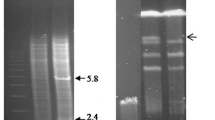Abstract
Wild-type strains of Penicillium islandicum and Penicillium frequentans, which produce anthraquinone and related compounds, were transformed to benomyl and hygromycin B resistance. Plasmids pSV50 and pBT6, with benomyl-resistant β-tublin genes, and plasmids pAN7-1 and pDH25, with a bacterial hygromycin phosphotransferase gene under the control of Aspergillus nidulans sequences, were used respectively. Transformation frequencies with these plasmids were 10–20 transformants per μg of DNA per 4-8×107 viable protoplasts. Intergration of plasmid DNAs into chromosomal DNAs was confirmed by Southern-blot analysis. Copy numbers and sites of integration varied among transformants. The integrated plasmid DNAs conferring a drug-resistant phenotype were mitotically stable with or without selection. The demonstration of such transformation systems is the essential first step in the application of recombinant DNA technology to study the biosynthetic genes of anthraquinone and related compounds in P. islandicum and P. frequentans.
Similar content being viewed by others
References
Biel SW, Parrish PW (1986) Isolation of DNA from fungal mycelia and sclerotia without the use of density gradient ultracentrifugation. Anal Biochem 154:21–25
Chang PK, Skory CD, Linz JE (1992) Cloning of a gene associated with aflatoxin B1 biosynthesis in Aspergillus parasiticus. Curr Genet 21:231–233
Cooley RN, Gorcom RFM, van den Hondel CAMJJ, Caten CE (1991) Isolation of a benomyl-resistant allele of the β-tublin from Septoria nodorum and its use as dominant selectable marker. J Gen Microbiol 137:2085–2091
Cullen D, Leong SA, Wilson LJ, Henner DJ (1987) Transformation of Aspergillus nidulans with the hygromycin resistance gene, hph. Gene 57:21–26
Curragh H, Marchant R, Mooibroek H, Wessels JGH (1990) Genetic transformation of the filamentous fungus Fusarium culmonum (abstract no 3). British Mycological Society, 8th General Meeting. Nottingham, United Kingdom
Durand N, Reymond P, Fevre M (1991) Transformation of Penicillium roqueforti to phleomycin and hygromycin B-resistance. Curr Genet 19:149–153
Fincham JRS (1989) Transformation in fungi. Microbiol Rev 53:148–170
Henson J, Blake NK, Pilgerm AL (1988) Transformation of Gaeumannomyces graminis to benomyl resistance. Curr Genet 14:113–137
Huang D, Bhairi S, Staples RC (1989) A transformation procedure for Botryotinia squamosa. Curr Genet 15:411–415
Hynes MJ (1986) Transformation of filamentous fungi. Exp Mycol 10:1–8
John MA, Peberdy JF (1984) Transformation of Aspergillus nidulans using the arg B gene. Enzymol Microbiol Technol 6:386–389
Kistler HC, Benny UK (1988) Genetic transformation of the fungal plant wilt pathogen, Fusarium oxysporum. Curr Genet 3:145–149
Kubo Y, Nakamura H, Kobayashi K, Okuno T, Fukusawa I (1991) Cloning of a melanin biosynthesis gene essential for approssorial penetration of Colletotrichum lagenarium. Mol Plant-Microbe Interact 4:440–445
Nara F, Watanabe I, Serizawa N (1993) Development of a transformation system for the filamentous, ML-236B (compactin)-producing, fungus Penicillium citrinum. Curr Genet 23:28–32
Nowak J, Kück U (1994) Development of an homologous transformation system for Acremonium chrysogenum based on the β-tublin gene. Curr Genet 25:34–40
Ohashi H, Akiyama H, Nishikori K, Mochizuki JI (1992) Asterric acid, a new endothelin-binding inhibitor. J Antibior 45: 1684–1685
Oliver RP, Roberts IN, Harling R, Kenyon L, Punt PJ, Dingemanse MA, van den Hondel CAMJJ (1987) Transformation of Fulvia fulva, a fungal pathogen of tomato. Curr Genet 12:231–233
Orbach MJ, Porro EB, Yanofsky C (1986) Cloning and characterization of the gene for β-tublin from a benomyl resistance mutant of Neurospora crassa and its use as a dominant selectable marker. Mol Cell Biol 6:2452–2461
Pontecorvo G, Roper JA, Hemmones LM, Macdonald KD, Bufton AW (1953) The genetics of Aspergillus nidulans. Adv Genet 5:141–238
Punt PJ, Oliver RP, Dingemanse MA, Pouwels PH, van den Hondel CAMJJ (1987) Transformation of Aspergillus based on the hygromycin B resistance marker from Escherichia coli. Gene 56:117–124
Queener SW, Ingolia TD, Skatrud PL, Chapman JL, Kaster KR (1985) A system for genetic transformation of Cephalosporium cremonium. In: Leivel (ed) Microbiology-1985. American Society for Microbiology, Washington DC, pp 468–472
Sambrook J, Fritsch EF, Maniatis T (1989) Molecular cloning: a laboratory manual (2nd edn) Cold Spring Harbor Laboratory, Cold Spring Harbor, New York
Sankawa U (1980) The biosynthesis of anthraquinonoids mycotoxins from, Penicillium islandicum Sopp and related fungi. In: Steyn PS (ed) The biosynthesis of mycotoxins. Academic Press, New York, pp 357–394
Skory CD, Chang PK, Cary J, Linz JE (1992) Isolation and characterization of a gene from Aspergillus parasiticus associated with the conversion of versicolorin A to sterigmatocystin in aflatoxin biosynthesis. Appl Environ Mircobiol 58:3527–3537
Thompson RH (1971) Naturally occurring quinones. Academic Press, London New York
Tilburn J, Scazzocchia C, Taylor GG, Zabichy-Zissman JH, Lockington RA, Davies RW (1983) Transformation by integration in Aspergillus nidulans. Gene 26:205–221
Ueno Y, Ueno I, Mizumoto K, Tatsuno T (1968) The binding of luteoskyrin, a hepatotoxic pigment of Penicillium islandicum Sopp, to deoxyribonucleohistone. J Biochem 63:395–399
Vollmer SJ, Yanofsky C (1986) Efficient cloning of genes of Neurospora crassa. Proc Natl Acad Sci USA 83:4869–4873
Wang J, Holden DW, Leong SA (1988) Gene transformation system for the phytopathogenic fungus Ustilago maydis. Proc Natl Acad Sci USA 85:865–869
Wnendt S, Jacobs M, Stahl U (1990) Transformation of Aspergillus giganteus to hygromycin B resistance. Curr Genet 17:21–24
Yelton MM, Hamer JE, Timberlake WE (1984) Transformation of Aspergillus nidulans by using a trpC plasmid. Proc Natl Acad Sci USA 81:1470–1474
Author information
Authors and Affiliations
Additional information
Communicated by K. Esser
Rights and permissions
About this article
Cite this article
Huang, Kx., Iwakami, N., Fujii, I. et al. Transformations of Penicillium islandicum and Penicillium frequentans that produce anthraquinone-related compounds. Curr Genet 28, 580–584 (1995). https://doi.org/10.1007/BF00518172
Received:
Issue Date:
DOI: https://doi.org/10.1007/BF00518172




